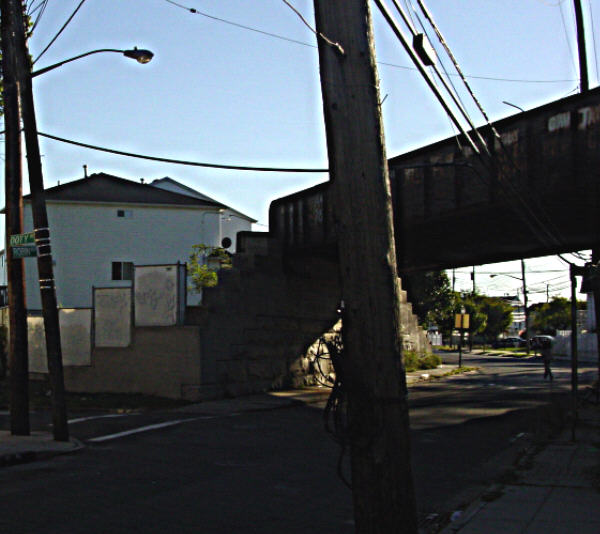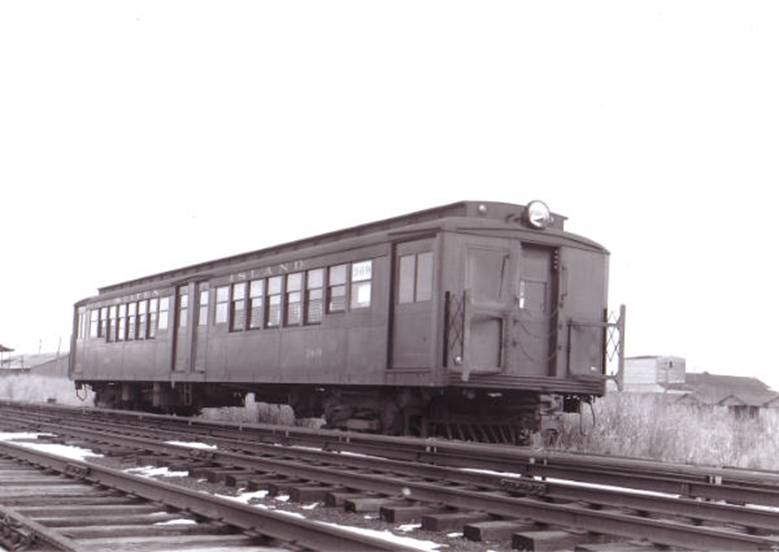Gary
Owen's
Welcome
to part two!
We
are now approaching...
Arrochar
The
Arrochar station (pronounced - AHH-ro-car)
was located at
The
Arrochar station with the old
Major Avenue overpass alongside in 1911.

Departing
the Arrochar station in the late 1940's.

Two
people pose for the camera on the St. George bound
platform of the Arrochar
station in 1943.
The
stairwell to the right leads up to

The
cozy Arrochar station as it was around 1947.
Most
of the rural background is now the
Photo
taken from the

at the Arrochar station in 1947.
I
believe the houses to the left still stand today.

And
now...in glorious color!

By
1964, all that remained was the staircase which once led to the Arrochar station. The displaced dirt- from the construction
of the approach to the Verrazzano Bridge- had taken
over.

A
Color
photo taken from

Again, leaving the
in the late 1940's or early 1950's.

Another
view of a
bound train leaving the Arrochar
station.
Photo taken from the
NOTE:
This photo- which may have been taken on
the last day of service (
is incorrectly listed on a few websites
as
Compare
this to the previous photo and see what I mean.

As
we continue down the line, we come across
There
was once an overpass here as evidenced by this photo.
It's
now filled in to accommodate new houses and a restaurant.
What's
with all the houses going up on
At
this rate, the island's going to sink.
Enough
already!

An aerial view of the filled in right of way and the new housing.
The bridge can still be detected by the cement in the middle of

At McClean and

The scene in 2004 with

The
abandonded ROW at the
with the

Next
stop...
Cedar
Avenue
The
A
the original wooden
Photo taken from the

The
original wooden platforms of
the

The
construction of the new
Cedar
Avenue station in 1937.

By
autumn, the
overhead walk were up and running.
Photo taken October, 1937.

Approaching
the
the last day of service:
McClean & Major Avenue overpasses
are visible in the background.

Two
undated color images
from the


A
St. George bound train arrives
at the
taken on the last day of service (

Same
view of the abandoned
station in 1965. When this photo was taken,
the station had been sitting dormant for 12 years.

A
view down the ROW towards
from Cedar and Retner Avenues.

In
1967, the dead
platforms continued to stand silently.

And
so we thank you for visiting
As
we go along...
...we
find ourselves at the Robin Road trestle in April, 1937.

The
abandoned Robin Road trestle facing
waiting patiently for reactivation that would
never come.

Facing
St. George in 1967...and still it waited in vain...

And
1971...zzzzzzzzzzzzzzz.

Jump ahead fifty plus years
and we find something a bit peculiar...
The Robin Road trestle alive and well in the
21st century!
Don't
even ask what the powers-that-be are thinking but as of this late date, 2023,
the trestle still spans Robin Road and stands defiant between the houses that
killed off the





Aerial view of the Robin Road trestle.

Now
we're making a sharp turn to the southwest
and pulling into our next station...
The
Here
is a 1907 Borough Hall survey for the area
around the
South to Midland Beaches. Passengers arriving
at

It
seems that during July 1901- while the construction of it's ROW was being built- the Southfield
Beach Railroad Company
ran into a few snags. click on the
following links
to read some archived articles from the New York Times.
These
are Adobe PDF files, you will need Adobe Reader to
open them:
A
steam engine pulls into the
One
year later, the S.I.R.T. would electrify all three branches.

Here
we see steam engine #16 at the
before electrification of all three lines. Pre- 1925.

Another
shot of a single S.I.R.T. train
rolling towards

Here
is the

Here is the sub-station as
it stood abandoned in 1967. The dirt and gravel trail is the original ROW.

And
the sub-station in it's final days in the 1980's -
90's


And again during the 1940's or 1950's.

This
next photo was taken by S.I.R.T. fan
Steve
Meyers circa late 1952...

...and
there's a story behind it:
The
owned and operated bus system on
fares and was on the verge of knocking the
SIRT out of business.
Realizing what the loss of the rail
system would mean to the Staten
Islanders, the NYCTA made a minor
concession-they wouldn't
compete directly with the SIRT'S main line to Tottenville,. This left the
railroad with only one of their three lines
protected and so they applied
for abandonment of the
And so it came to pass that I and my
photo buddy, Will Faxon, found
ourselves at the grade crossing at the outer end
of the
taking photos of the operation. After covering
the area pretty well, we
were perplexed as to why the crossing gates
were not operating but were
m
then only using single car trains. So we
asked the gateman. He told us,
in highly Italian accented English that
the line always used gatemen
after the summer rush was over; apparently it
was less expensive
than using mechanical gates. Then he shyly
asked me
if I would take a photograph of him
"to send to my family in the old country".
I quickly agreed at which point he
disappeared into his shack for a moment,
emerging, not only with his red caution flag but
also with a tall STOP sign.
And he was grandly wearing his official,
dusty, obviously rarely used,
official crossing guard hat. Proudly, he posed when the next
train came down the line,
his face glowing with happiness that somebody cared enough
to notice him in
his position of importance at a lonely
railroad crossing in
I don't recall if he ever received his
copy of the photo I sent to him in
care of the SIRT but I was proud as anything
to have captured such a
memorable moment on film. And if you check the
internet for photos of
the SIRT in action, you'll probably see a
copy of this picture, taken as a
railroad was about to lose some of the pride and
glamour that made
railroading such an interesting subject.
Steve Meyers, March 2011
Thank
you Steve!
A different
S.I.R.T. worker, wearing his amazing pink sweater
and checkered cap, stops traffic at the
Again,
the power sub-station is at the right.
Photo taken last day of service.
Gee, what day could that be?

Two
views of the


Here's
one I had to cut in two as my
sc
It
shows a bird's eye view of the South Beach station facing Sand Lane.
The
photo was most likely taken in the late 1940's or early 1950's.


A
single car (#303) stops at the South Beach station
on it's way to the end of the line on the last day of service:
Tuesday,
March 31, 1953.
By
now I am sure you have memorized that date.

Candid
shots of two-car trains at the
The
double cars were mostly used during rush hour.
The
power sub-station stands in the background.


An
S.I.R.T. conductor calls out from the back of
a St. George bound train at the

Two-car
rush hour or fan ride train arrives
at the

A
train leaving the

A terrific shot of the

Last day of service, perhaps?

A
group of kids gather to watch a single train
leave
Service
ended at
Mr.
Stop Sign was still doing his job.

An undated photo of the crossing at
This
could be after the line was abandoned.

A depressing scene.
The
dead
Photo
taken mid 1950's to mid-1960's.

We're
not finished yet...
An
S.I.R.T. train rolls beyond the

And another on

A
lonely S.I.R.T. train travels beyond
the

An interesting view back towards the

But
wasn't this the end of the line?
Not
quite.
This
next and last station on the
Wentworth
Avenue
Yes!
The mighty
I
asked Ed Bommer if he had ever traveled to or from
the
No, I never did ride to or get on at
There were some people who did, as they
lived in that area, beyond
During WW II it was kept dimmed and
darkened because of the German U-boats off of
They were controlled by the ticket agent
at the
When ticket agents weren't needed anymore,
the crew of the first train in would turn the lights on.
The crew of the last train out for the day
would turn them off.
This was true for many SIRT stations.
An
S.I.R.T. train at the

Here's
a color slide circa 1953. We are looking
southwest towards what is now
Since
the
I
wonder if this was taken after the line closed?

Are
these the actual S.I.R.T.
plans / dimensions for the

A
rare view of the
a three car Rail Fan train parked on the siding.

Another view of everyone's favorite train station.
Notice
the "South Beach" sign on the train.

An undated
photo of a train picking up passengers
at the

Various
S.I.R.T. employees chat on the

Two
more views of the
Station. Photos taken in
November, 1949.


Various
views of the
the late 1940's-early 1950's.









A
more recent aerial view of where the
the Southfield Beach Railroad's trolley line.
The
latter runs parallel with and beyond the access road.
I
wonder if much of that trolley ROW still exists? Guess
I'll have to take a meander down there and check it out!
I'll
bet the

Here
are two views of the same place in the 1920's.
This
photo pre-dates 1925- the year in which
the
The
South Beach station is at upper right and SIRT trains
rest at the end of
the station would be built. The Southfield Beach Railroad ROW is
clearly visible. Happy Land amusement park is visible
at the bottom right of each photo.


A
vintage aerial view of the general area around
The
Southfield Beach Railroad ("trolley right of way") is outlined.

End Of The
Line!
So
there you have it.
My little tribute to Staten Island Rapid Transit's
Gary Owen's S.I.R.T. North
Shore Line Page
If
you have any photos of the SIRT South Beach Line that would like to share,
please send me an email at:
Thanks
to the following generous people and sites:
Kevin Walsh's
Forgotten New York Page
St.
George Library Center (NYPL)
Ed
Bommer
Silver Leaf Transit
Joseph Scozzare
David
Pirmann
Joe
Testagrose
Anthony
Paonita
George
Conrad
Bob
Ryan
Frank
Gaetani
Google Earth
Steve Meyers
Reverend
Greg
Marc
Pitanza
and of course...
Captain
Red Dog! (1948-2016) :(
Back
To Gary Owen's S.I.R.T.
South Beach Line Page Part One